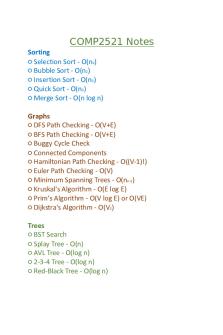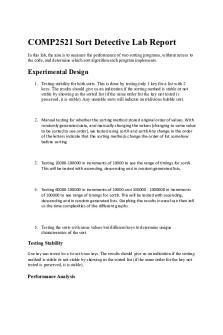COMP2521 21T1 - Week 07 Lab Solution PDF

| Title | COMP2521 21T1 - Week 07 Lab Solution |
|---|---|
| Course | Data Structure & Algorithms |
| Institution | University of New South Wales |
| Pages | 5 |
| File Size | 309 KB |
| File Type | |
| Total Downloads | 73 |
| Total Views | 146 |
Summary
COMP2521 21T1 - Week 07 Lab Solution...
Description
solveBfs
1
#define MAX_NEIGHBOURS 4
2 3
static void fillPath(Maze m, Cell start, Cell exit, Cell **pred);
4 5
static bool validCell(Maze m, Cell c);
6
bool solve(Maze m) {
7
int height = MazeHeight(m);
8 9
int width = MazeWidth(m);
10
bool **visited = createBoolMatrix(height, width);
11
Cell **pred = createCellMatrix(height, width);
12 13
Queue q = QueueNew();
14 15
Cell start = MazeGetStart(m);
16 17
QueueEnqueue(q, start);
18
bool found = false;
19
while (!found && !QueueIsEmpty(q)) {
20 21
Cell v = QueueDequeue(q);
22
if (visited[v.row][v.col]) {
23
continue;
24 25
}
26
visited[v.row][v.col] = true;
27
if (MazeVisit(m, v)) {
28 29
fillPath(m, start, v, pred); found = true;
30
break;
31
}
32 33
Cell adj[MAX_NEIGHBOURS] = {
34
{ .row = v.row - 1, .col = v.col
35
{ .row = v.row,
36 37
{ .row = v.row + 1, .col = v.col }, // down { .row = v.row, .col = v.col - 1 }, // left
38
}, // up
.col = v.col + 1 }, // right
};
39 40 41
for (int i = 0; i < MAX_NEIGHBOURS; i++) { Cell w = adj[i];
42
if (validCell(m, w) && !MazeIsWall(m, w) && !visited[w.row][w.col]) {
43
QueueEnqueue(q, w);
44 45
pred[w.row][w.col] = v; }
46
}
47
}
48 49
QueueFree(q);
50 51
freeBoolMatrix(visited);
solveDfs solveBfs
1
#define MAX_NEIGHBOURS 4
2 3
static void fillPath(Maze m, Cell start, Cell exit, Cell **pred);
4 5
static bool validCell(Maze m, Cell c);
6
bool solve(Maze m) {
7
int height = MazeHeight(m);
8 9
int width = MazeWidth(m);
10
bool **visited = createBoolMatrix(height, width);
11
Cell **pred = createCellMatrix(height, width);
12 13
Stack s = StackNew();
14 15
Cell start = MazeGetStart(m);
16 17
StackPush(s, start);
18
bool found = false;
19
while (!found && !StackIsEmpty(s)) {
20 21
Cell v = StackPop(s);
22
if (visited[v.row][v.col]) {
23
continue;
24 25
}
26
visited[v.row][v.col] = true;
27
if (MazeVisit(m, v)) {
28 29
fillPath(m, start, v, pred); found = true;
30
break;
31
}
32 33
Cell adj[MAX_NEIGHBOURS] = {
34
{ .row = v.row - 1, .col = v.col
35
{ .row = v.row,
36 37
{ .row = v.row + 1, .col = v.col }, // down { .row = v.row, .col = v.col - 1 }, // left
}, // up
.col = v.col + 1 }, // right
};
38 39
for (int i = 0; i < MAX_NEIGHBOURS; i++) { Cell w = adj[i];
40 41
if (validCell(m, w) && !MazeIsWall(m, w) && !visited[w.row][w.col]) {
42 43
StackPush(s, w);
44 45
pred[w.row][w.col] = v; } }
46 47
}
48 49
StackFree(s);
50 51
freeBoolMatrix(visited);
============ solveBfs ============ - Worst case time complexity: O(n) - Explanation: Each cell has at most four neighbours, so when we visit a cell, we add queue. Since we visit each cell at most once, at most 4n cells will be added to the qu have at most 4n iterations. All operations in the loop, including the queue operations time, so the time complexity is O(n). ============ solveDfs ============ - Worst case time complexity: O(n) - Explanation: Each cell has at most four neighbours, so when we visit a cell, we add stack. Since we visit each cell at most once, at most 4n cells will be added to the st have at most 4n iterations. All operations in the loop, including the stack operations time, so the time complexity is O(n)....
Similar Free PDFs

COMP2521 - notes
- 20 Pages

FIT1047 Lab Week 4 Solution
- 3 Pages

Chapter 07 - Solution Manual
- 20 Pages

TIB210 Week 07
- 10 Pages

FIT1047-Lab-Week-4 5 Solution
- 7 Pages

Comp2521 notes
- 31 Pages

COMP2521 Notes
- 34 Pages

F17 Lab 07 - Thermochemistry
- 10 Pages

QUIZ Guide - WEEK 07 - Hola
- 1 Pages

WEEK 3 LAB - lab
- 2 Pages

Week 12 tutorial solution
- 7 Pages

Week 9 Tutorial Solution
- 6 Pages
Popular Institutions
- Tinajero National High School - Annex
- Politeknik Caltex Riau
- Yokohama City University
- SGT University
- University of Al-Qadisiyah
- Divine Word College of Vigan
- Techniek College Rotterdam
- Universidade de Santiago
- Universiti Teknologi MARA Cawangan Johor Kampus Pasir Gudang
- Poltekkes Kemenkes Yogyakarta
- Baguio City National High School
- Colegio san marcos
- preparatoria uno
- Centro de Bachillerato Tecnológico Industrial y de Servicios No. 107
- Dalian Maritime University
- Quang Trung Secondary School
- Colegio Tecnológico en Informática
- Corporación Regional de Educación Superior
- Grupo CEDVA
- Dar Al Uloom University
- Centro de Estudios Preuniversitarios de la Universidad Nacional de Ingeniería
- 上智大学
- Aakash International School, Nuna Majara
- San Felipe Neri Catholic School
- Kang Chiao International School - New Taipei City
- Misamis Occidental National High School
- Institución Educativa Escuela Normal Juan Ladrilleros
- Kolehiyo ng Pantukan
- Batanes State College
- Instituto Continental
- Sekolah Menengah Kejuruan Kesehatan Kaltara (Tarakan)
- Colegio de La Inmaculada Concepcion - Cebu



